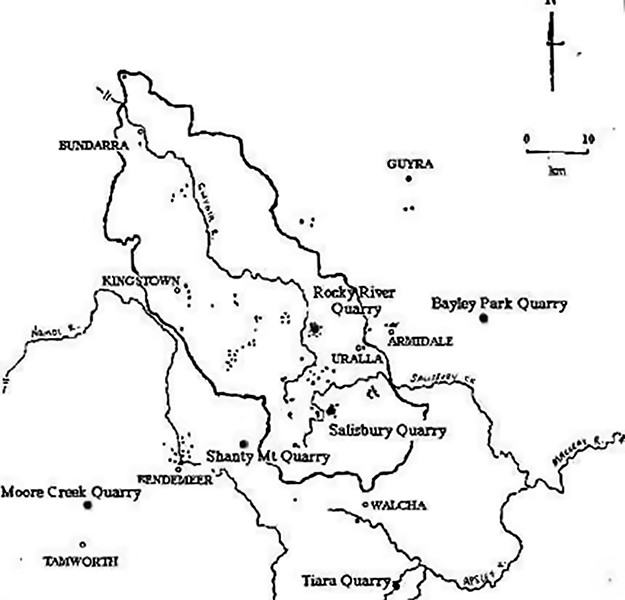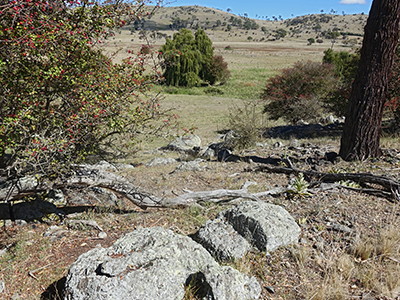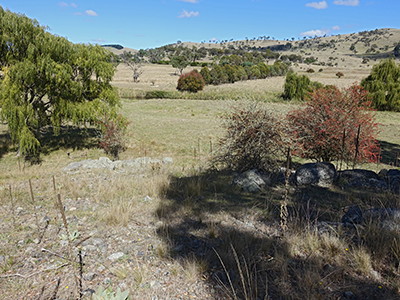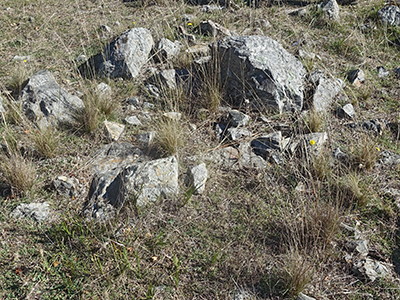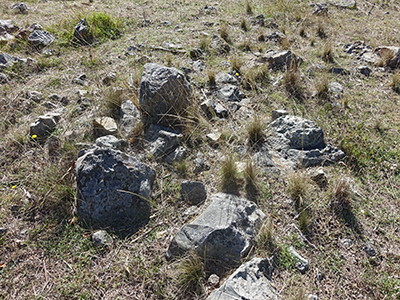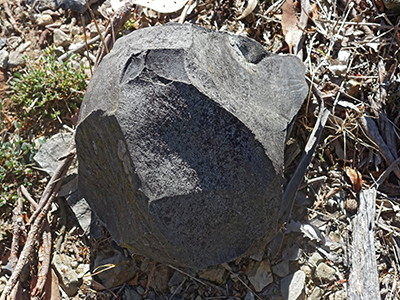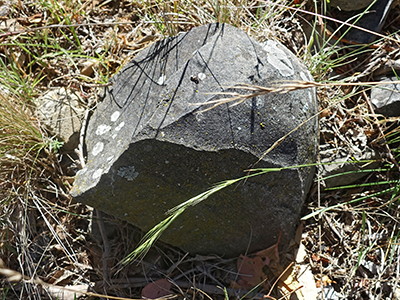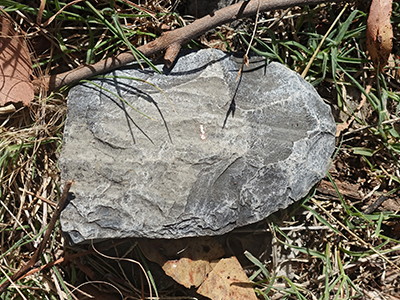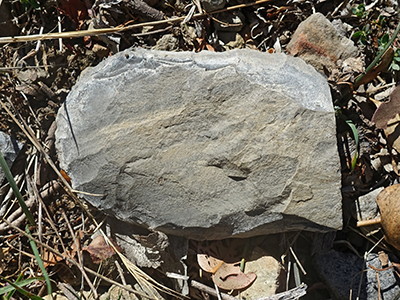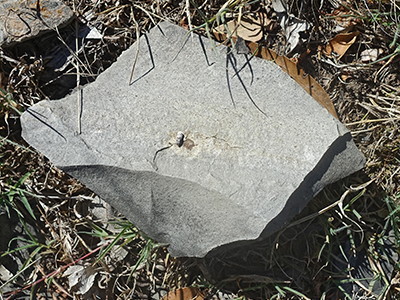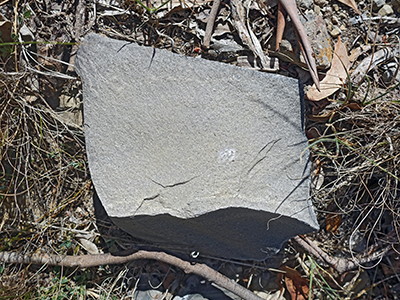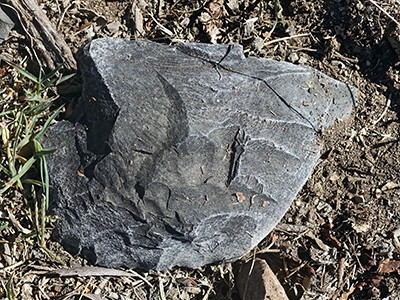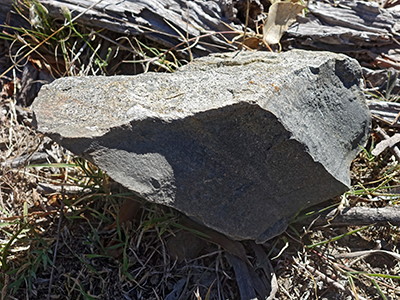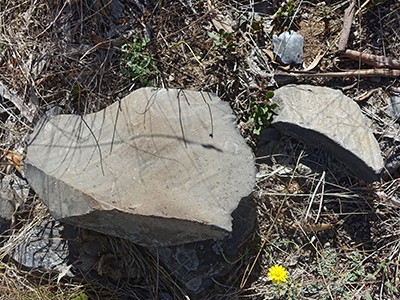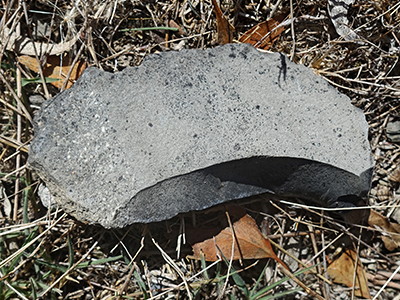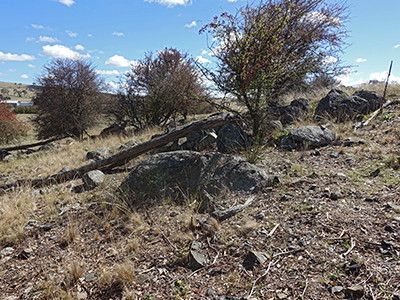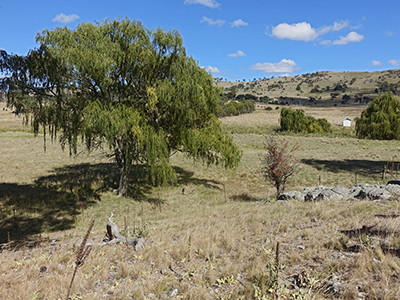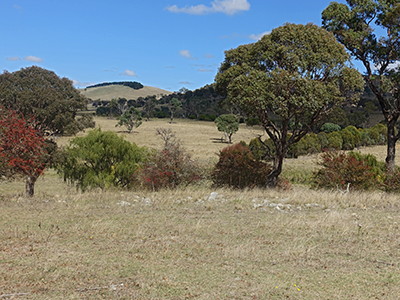Back to Don's Maps
 Back to Archaeological Sites
Back to Archaeological Sites
Salisbury Axe Quarry
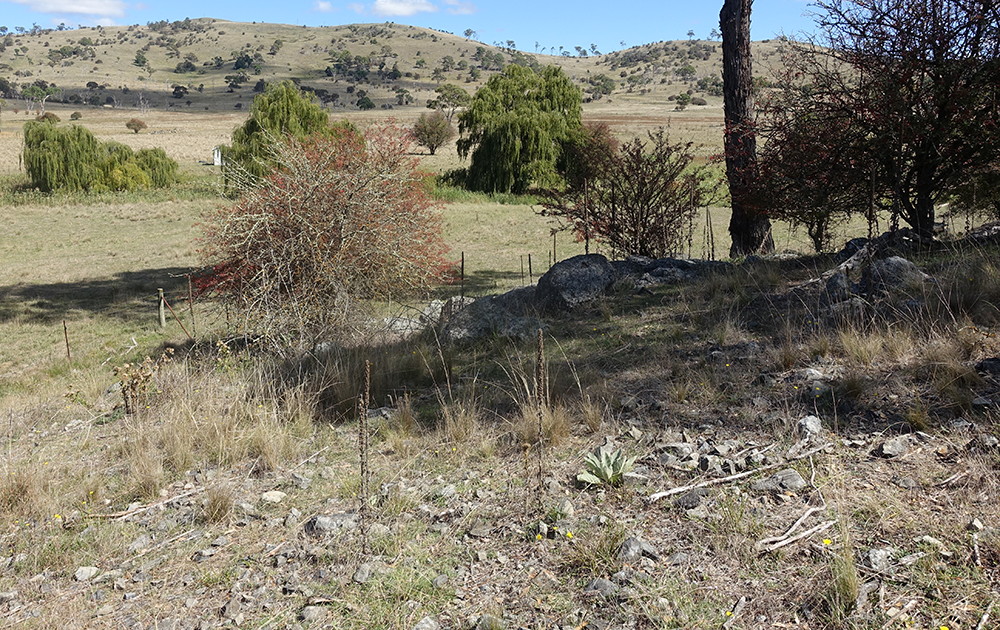
Salisbury Axe Quarry.
There was an eel trap in the creek where the Willow trees are in this image.
Photo: Don Hitchcock 2018
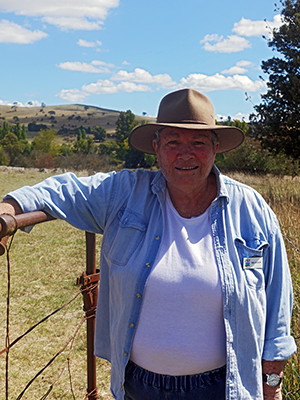
Sue Hudson has done a huge amount of very valuable and professionally completed scientific work in researching and reporting on this site, and others in the area.
Photo: Don Hitchcock 2018
Thesis abstract 'Salisbury Axe Quarry: The Acquisition, Distribution and Cross-Exchange Patterns from a Local Distribution Site'
Suzanne Hudson
BA(Hons), Department of Archaeology and Palaeoanthropology, University of New England, Armidale, October 1996
This thesis analysed quarry products and their distribution across the landscape in order to obtain information on past exchange systems, technologies, social relations and population movements. It focused on the spatial distribution and technological variation apparent in stone from the Salisbury Aboriginal stone axe quarry, situated near Uralla in northern New South Wales. The results were then interpreted in terms of the social and resource landscape.
According to Binns and McBryde (1972), the Salisbury quarry was of 'local' rather than 'long transfer' type with a restricted dispersal of products. My study confirmed this finding but also showed that the Salisbury stone was highly patterned in its dispersal. Basically, no axes were found to the east of the quarry, but some specimens had been moved up to 50 km to the west. This pattern of dispersal closely matched the nature of the social relations between Aboriginal groups observed in the historic period. Specifically, there was traditional enmity between people of the New England Tablelands and the coast. In addition, the density of axe distribution closely matched the distribution of food resources.
The thesis also studied axes made from exotic material found in the Salisbury region. Most of the 'exotic' stone was provenanced to the Daruka quarry at Moore Creek some 80 km to the south. Exotic axes were found to be of similar size to axes made from local materials.
I also systematically examined surface material from selected sample squares within the Salisbury axe quarry in order to obtain information on manufacturing processes and dispersal patterns. Artefacts remaining at the quarry were then compared with off-site material. By gaining an understanding of the use of the Salisbury quarry, it was possible to interpret the importance of the minor quarries within the local area and the significance of exotic quarries to the Aboriginal people who once lived in the study area. The major findings of the study did not always agree with the hypotheses formulated by earlier researchers in the New England region. For instance:
1. Interpretation of the resource landscape indicates that the area was possibly not as resource-poor in stone and food resources as originally thought.
2. Oral history refers to the Tablelands people spending winters at the coast: this appears unlikely as the numbers of axes define the movement of people to the west of the region. There was a preference for locally obtained raw material over that from Moore Creek. The exotic material was not regarded as prestige but as utilitarian material.
3. A 'no-person-zone' has been identified to the east of the quarry, as no axes from either Salisbury or eastern sources were found in this area. Godwin (1990) states that linguistic evidence points to a break between eastern groups and the Anaiwan people living in the Uralla area.
4. Belshaw (1978) states that the Anaiwan area was used as a 'marchland' between two powerful groups, the Gamilaroi and Dainggati. This appears not to be the case, as there is no crossover of axes from the eastern groups.
5. No axes have been found near Mt Yarrowyck (an art site). It is suggested that this area was used for religious purposes only and that hunting was not carried out around the site.
References
Belshaw, J. 1978 Population distribution and the pattern of seasonal movement in northern New South Wales. In I. McBryde (ed.), Records of Times Past, pp.65–8 1. Canberra: Australian Institute of Aboriginal Studies.
Binns, R.A. and I. McBryde, 1972 A Petrological Analysis of Ground-Edge Artefacts from Northern New South Wales. Canberra: Australian Institute of Aboriginal Studies.
Godwin, L. 1990 Inside Information: Settlement and Alliance in the Late Holocene of Northeastern New South Wales. Unpublished PhD thesis, Department of Archaeology and Palaeoanthropology, University of New England, Armidale.
Authors: Hudson, S.
Title: Thesis abstract 'Salisbury Axe Quarry: The Acquisition, Distribution and Cross-Exchange Patterns from a Local Distribution Site'
Date: June 1997
Volume: 44 Pages: 67–68 Type: Thesis Abstracts
This map by Suzanne Hudson indicates the Uralla Shire boundary, the river system and Anaiwan quarries with red dots and the sites where axes and blanks have been found with black dots.
Photo: Hudson (1997)
Proximal Source and text: Rosen et al. (2009)
The site is one where the last (quartz rich) explosion of a volcano produced an ash flow (or, rarely, air-fall deposits) of quartz-rich very hot material, which welded into a visibly layered but homogenous, hard, and vitrified rock.
This would have occurred in either a zone of partial welding, for which some samples have lost all their pore space, or in what is called the zone of dense welding, where the complete coalescence of the glassy fragments has resulted in the elimination of all pore space. This can sometimes produce a dense black glass, although not in this case.
This vitrified or welded tuff is ideal for axe blades.
Photo: Don Hitchcock 2018
Reference text: Smith (1961)
The local tribes were able to get blanks for axe heads by the use of fire to split off well sized cores which could then be further split if necessary by repetition of the fire treatment, or by ordinary percussion methods to make the particular size of axe blanks needed.
Photo: Don Hitchcock 2018
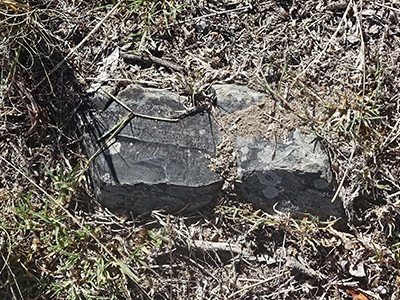
After initial splitting of very large rocks using fire, the resultant large pieces with flat fracture planes were subjected to further fire treatment to obtain many useable sizes of blanks.
This blank shows evidence of the fire used in this secondary treatment, on the initial fracture plane.
Photo: Don Hitchcock 2018

Although tuff is normally a fairly soft rock, this vitreous tuff (also called welded tuff) is unusual in that it was so hot when it was laid down that it welded together into a vitreous mass, creating a very hard material.
This particular example shows well the banding from the layers successively deposited from eruptions which were close together in time, and of very hot and slightly differently coloured material, which subsequently formed one coherent and glassy mass.
Photo: Don Hitchcock 2018

This is a small axe blank, knapped from a core, rejected for some reason, lying on top of a much larger piece of rock split from the quarry rock.
Photo: Don Hitchcock 2018
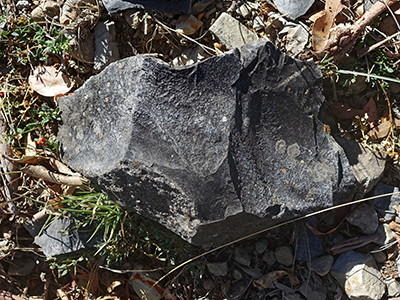
These three cores bear the scars of the large flakes taken from them for use as axe blades.
Photo: Don Hitchcock 2018
Two sides of the same axe blank. It was prepared for use as an axe blade by shaping and by preparation of the edge by rough knapping on both sides, but was then abandoned.
Photo: Don Hitchcock 2018
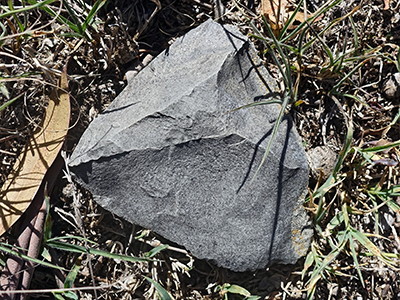
These three fairly large flakes were ready for final shaping.
Photo: Don Hitchcock 2018
These two cores illustrate the variable nature of the rock.
On the left is a core which turned out to be difficult to get decent large flakes from, while the one on the right shows the scars of several successful large flakes being struck from it.
Photo: Don Hitchcock 2018
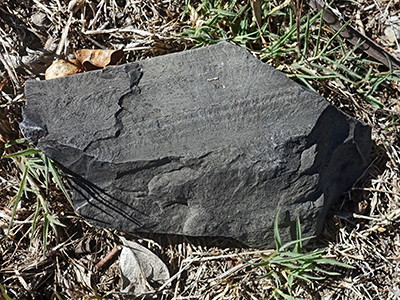
This unaltered product of the fire splitting technique shows the dark remains of the fire, but was found to be unsuitable for further use.
Here we can see the banding of the layered nature of the rock.
Photo: Don Hitchcock 2018
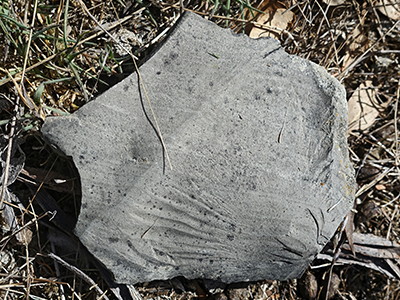
These three large products of the spalling by either the fire process or knapping techniques were not suitable for further knapping as an axe.
The craftspeople could afford to be choosy, since there was so much material in this outcrop.
Photo: Don Hitchcock 2018
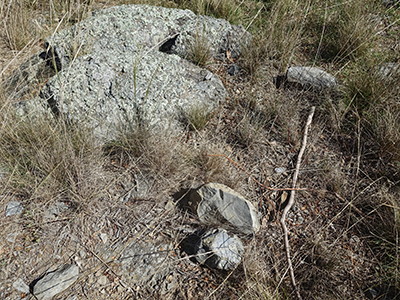
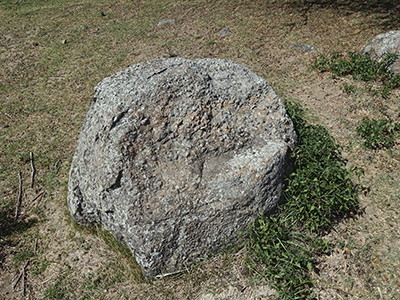
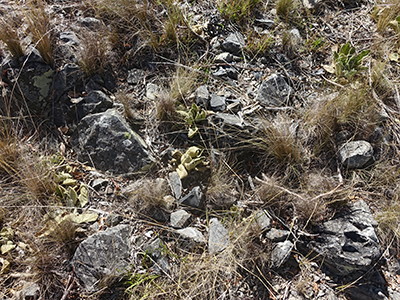
These three photographs show vividly the original outcrops of rock, thick with lichen, above, and the broken large and small pieces resulting from the reduction in size of the original boulders by thermal shock on the left.
The axe makers may have thrown water on the rock to facilitate the process.
Photo: Don Hitchcock 2018
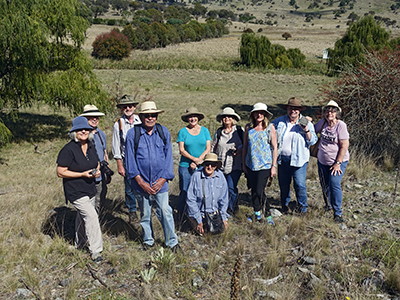
Sue Hudson (second from the right) kindly led a group of us to the site, and gave a wonderful insight into the entire area.
It is thought to have been used as an axe quarry for circa ten thousand years, since the end of the last ice age.
Photo: Don Hitchcock 2018
The area overlooks an idyllic valley, where there would have been plenty of game, and eels in the creek.
The axe blank gatherers would have not lacked for sustenance while they worked.
Photo: Don Hitchcock 2018
References
- Belshaw J., 1978: Population distribution and the pattern of seasonal movement in northern New South Wales. In I. McBryde (ed.), Records of Times Past, pp.65–8 1. Canberra: Australian Institute of Aboriginal Studies.
- Binns R., McBryde I., 1972: A Petrological Analysis of Ground-Edge Artefacts from Northern New South Wales, Canberra: Australian Institute of Aboriginal Studies..
- Godwin L., 1990: Inside Information: Settlement and Alliance in the Late Holocene of Northeastern New South Wales, Unpublished PhD thesis, Department of Archaeology and Palaeoanthropology, University of New England, Armidale.
- Hudson S., 1997: Thesis abstract 'Salisbury Axe Quarry: The Acquisition, Distribution and Cross-Exchange Patterns from a Local Distribution Site', Date: June 1997 Volume: 44, pp 67–68, Thesis Abstracts, Department of Archaeology and Palaeoanthropology, University of New England, Armidale.
- Rosen S. et al., 2009: Uralla Shire Council, Uralla Community Based Heritage Study, MFA Stage 1 Draft 16 October 2009
- Smith R., 1961: Zones and zonal variations in welded ash flows, in: Geological Survey Professional Paper, Volume 354, U.S. Government Printing Office, 1961 - Geology
Back to Don's Maps
 Back to Archaeological Sites
Back to Archaeological Sites
